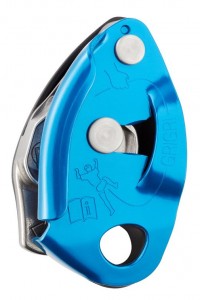Gadgets, Knots and Climbing Classes
Indoor Climbing Gear:
Rock climbing employs a variety of interesting gadgets and knots to assist in mitigating the risks involved with the sport. Learning about modern climbing gear, high-tech ropes and state-of-the-art risk management practices is interesting and a big part of the fun.
You will experience these gadgets and knots first-hand when you try indoor rock climbing:
- The retrace figure-8 knot: This is the knot used to securely attach one end of a high-tech rope to the climber's harness. The rope goes up and around the anchor at the top of the route (a 'top-rope' climb) and then down through the belayer's belay device attached to his/her harness. The belayer is the person on the ground.
- The Belayer's GriGri or ATC (Air Traffic Controller): Belay devices can lock onto the rope or create a varying amount of friction on the rope that lets the belayer easily hold the climber in place, or slowly lower their climber to the ground. The belay device is securely connected to the belayer's harness by a carabiner. The GriGri (gree-gree) is considered the gold standard of active assisted braking belay devices, but is a bit expensive ($95).
- The Anchor System: On top-rope climbing routes, the rope runs from the belayer up to a permanent high-strength engineered steel anchor system at the top of the route. The rope winds one and a half turns around the 6" diameter horizontal anchor pipe and then down to the climber. The friction added by that one and a half turns of the rope removes a large amount of the climber's weight from the belayer, making his or her job much easier. This allows a light belayer to easily belay a much heavier climber.
- Edelrid's Mega Jul and Jul2 are great examples of belay devices with passive assisted braking. Simpler than active assisted braking belay devices, they have the inherent reliability of no moving parts, the advantage of low cost ($35) and the strength of stainless steel. Both types of belay devices (active and passive assisted braking) are demonstrated, discussed and used in the Boomer Climbers' Movement Class. The Edelrid Jul2 is my favorite belay device for indoor top-rope climbing.
- Belay devices coming in 2018: Advanced assisted braking belay devices continue to improve. A couple of these new belay devices have built-in safeguards to help ensure that a panic response by the belayer doesn't result in a fall - like the new GriGri Plus.
- Auto-Belays: Climb Iowa has a number of climbing routes equipped with automatic belay systems. These routes require no climbing partner/belayer, as auto-belays automatically lower you slowly to the ground whenever you let go. To watch Boomers climbing on auto-belays, click on Tom or Kitty.
- Classes: I recommend Climb Iowa's Boomer Climbers' Movement class for adults 50 and over, or its equivalent in the rock climbing gym near you. It's the best way to learn about indoor top-rope rock climbing and its extensive risk management practices. Taking a separate belay-certification class during the month-long Boomer classes is also included. Becoming belay-certified allows you to belay your friends, children and/or grandchildren. Trust me, grandkids look at you differently after you take them rock climbing at your local indoor climbing gym.

